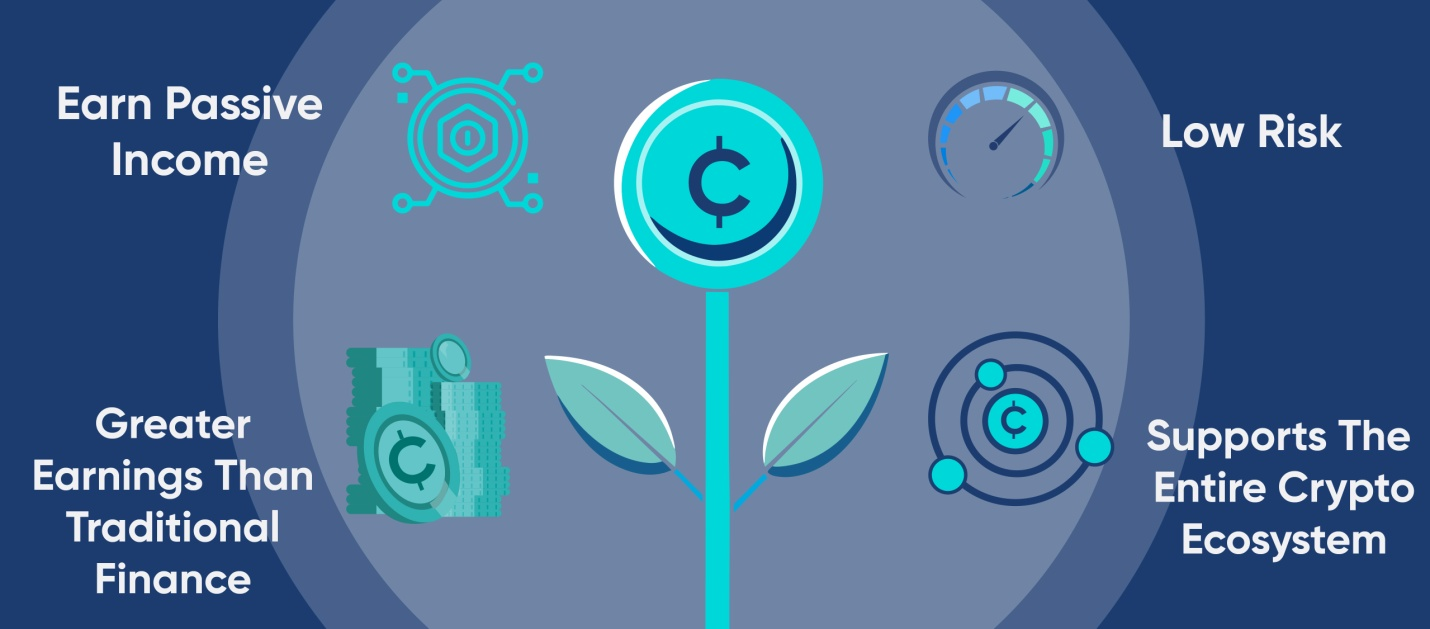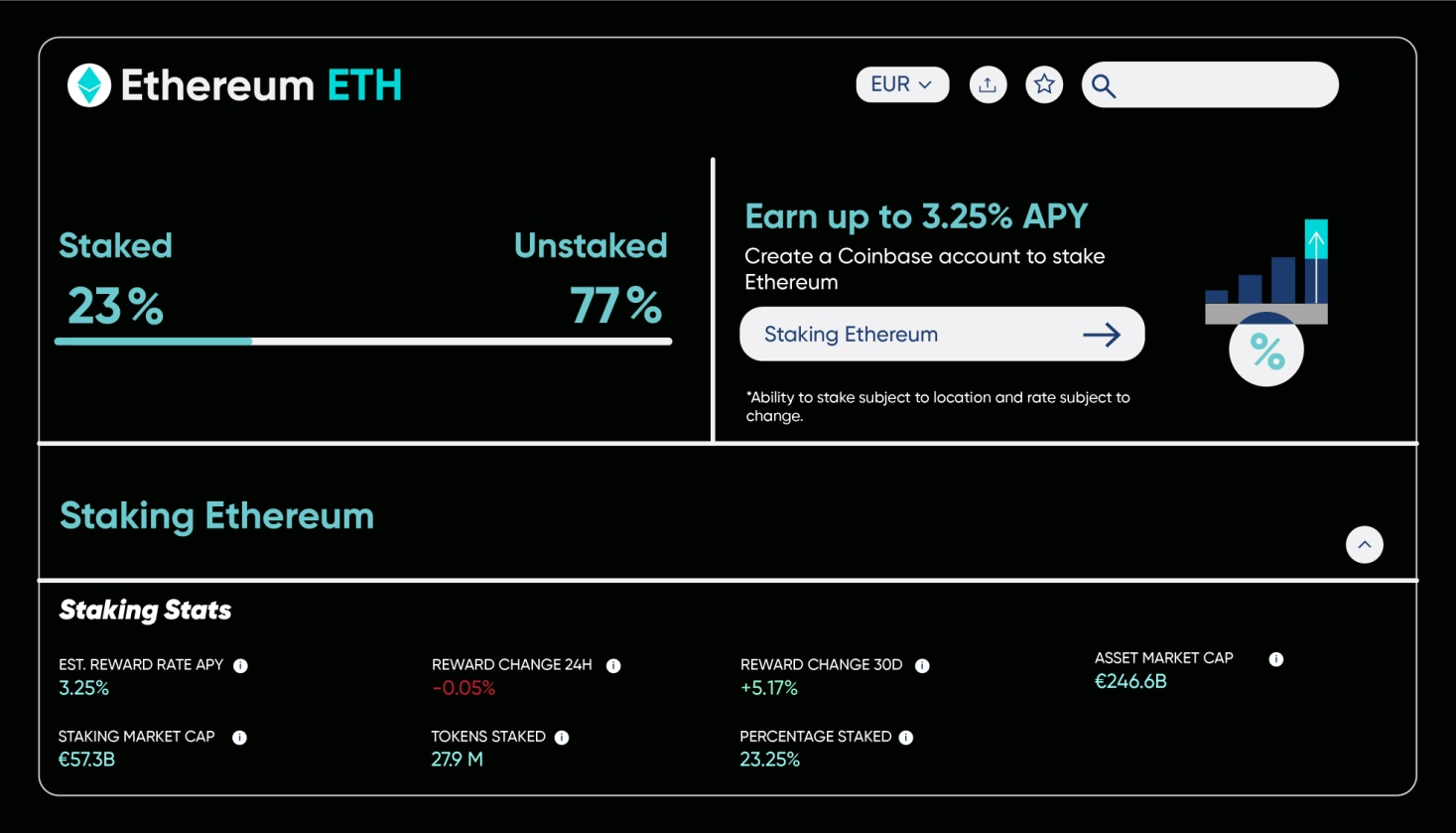
The world of digital assets has exploded in recent years, with Bitcoin, Ethereum, and a vast array of innovative projects capturing the imagination of investors worldwide. But simply “HODLing” (holding on for dear life), your crypto isn’t the only path to success in this dynamic market. Just like traditional finance, digital assets offer a wealth of strategies for maximizing returns and achieving your financial goals.
Staking: Earning Rewards by Holding
Staking serves as a fundamental mechanism within Proof-of-Stake (PoS) blockchains, offering investors the opportunity to contribute to the network’s validation process by locking up their assets for a predetermined period. In exchange, they receive rewards in the form of additional tokens. This process presents a relatively passive investment approach, appealing to individuals with a long-term investment horizon who possess faith in the underlying project’s potential. Nevertheless, staking is not devoid of drawbacks and nuances, necessitating a thorough understanding of its pros and cons.
Pros:
Passive Income Generation: Staking enables investors to earn passive income through their participation in network validation. This passive income stream can supplement traditional income sources or serve as a primary revenue stream for those committed to staking full-time.
Supporting Network Security: By staking their assets, investors contribute to the security and decentralization of the blockchain network. This incentivizes participants to act in the network’s best interest, enhancing its overall resilience against malicious actors.
Alignment of Incentives: Staking aligns the incentives of token holders with the network’s success. As stakeholders stand to benefit from the network’s growth and stability, they are motivated to actively participate in its governance and development.
Potential for Capital Appreciation: Beyond earning staking rewards, investors may also benefit from potential capital appreciation if the value of the staked tokens increases over time. This dual incentive structure can amplify overall returns for stakers.
Cons:
Fluctuating Staking Rewards: Staking rewards are subject to fluctuations based on network activity, token price volatility, and other variables. Therefore, investors may experience variability in their staking rewards, which can impact the predictability of their passive income stream.
Lock-up Periods: Staking typically involves locking up assets for a predetermined period, during which they cannot be readily accessed or traded. This lack of liquidity may pose a challenge for investors who require flexibility in managing their assets.
Risk of Slashing Penalties: In PoS blockchains, validators risk facing slashing penalties if they engage in malicious behavior or fail to fulfill their staking responsibilities. These penalties can result in the loss of a portion of the staked assets, adversely affecting investors’ returns.
Minimum Investment Requirements: Some staking platforms impose minimum investment requirements, excluding smaller investors or individuals with limited capital from participating in staking activities. This accessibility barrier may limit the inclusivity of staking as an investment option.
Example: Alice decides to stake her Ethereum (ETH) holdings on a reputable staking platform, anticipating a yearly reward of 5% in additional ETH. While this allows Alice to generate passive income, she acknowledges the inherent risks, including fluctuating rewards and the possibility of slashing penalties. Nonetheless, she remains confident in her decision, believing in the long-term potential of Ethereum and the benefits of staking as a form of investment.

Yield Farming: High Potential, High Risk
Yield farming stands as a dynamic strategy within the realm of Decentralized Finance (DeFi), where participants aim to optimize returns on their digital assets. By leveraging DeFi protocols, users engage in various liquidity-providing activities, such as depositing crypto into liquidity pools, which fuel peer-to-peer lending and borrowing processes. In return for their contributions, participants receive rewards in the form of the protocol’s native tokens and a portion of the generated trading fees. While yield farming offers the potential for significantly higher returns compared to traditional investment avenues like staking, it is accompanied by a set of nuanced pros and cons that investors must carefully consider.
Pros:
High Potential Returns: Yield farming presents the opportunity for participants to earn substantial returns on their crypto holdings, often surpassing those achievable through conventional investment methods like staking or savings accounts. The ability to capitalize on various DeFi protocols and liquidity pools can amplify potential profits for yield farmers.
Diversification of Income Streams: By engaging in yield farming across multiple DeFi protocols, investors can diversify their income streams and mitigate risk. This diversification strategy helps distribute risk exposure, safeguarding against potential losses stemming from the underperformance of a single protocol.
Access to New Opportunities: Yield farming provides users with access to innovative DeFi projects and protocols, allowing them to participate in emerging trends within the cryptocurrency ecosystem. This early adoption potential can lead to lucrative opportunities for yield farmers who identify and capitalize on promising projects.
Incentivizing Liquidity Provision: Through yield farming, DeFi protocols incentivize liquidity provision, thereby enhancing the efficiency and liquidity of decentralized markets. This increased liquidity benefits all participants by reducing trading slippage and improving market depth.
Cons:
Heightened Risk Profile: Yield farming carries a higher risk profile compared to traditional investment strategies due to the inherent volatility and complexity of DeFi protocols. Participants may encounter smart contract vulnerabilities, protocol exploits, or economic risks that could result in significant financial losses.
Impermanent Loss: Participants in liquidity pools may experience impermanent loss, wherein the value of their deposited assets decreases relative to holding them outside the pool. This occurs due to fluctuations in the price of the assets and can offset the gains from yield farming rewards.
Protocol Risks: DeFi protocols are subject to constant evolution and experimentation, leading to uncertainties regarding their reliability and security. Participants risk exposure to protocol failures, hacks, or rug pulls, which could result in the loss of deposited assets and accrued rewards.
Market Volatility: The value of reward tokens received through yield farming can be highly volatile, subject to market speculation and sentiment. Participants may face challenges in accurately assessing and managing the risks associated with holding and trading these tokens.
Example: Bob decides to engage in yield farming by depositing his USD Coin (USDC) into a DeFi lending pool, attracted by the promise of a yearly yield of 10% in the platform’s native token. Despite earning interest and receiving rewards, Bob remains cognizant of the risks involved, particularly the potential for impermanent loss if the price of the native token experiences a significant decline. He monitors market conditions closely, ready to adjust his strategy accordingly to mitigate potential losses while capitalizing on yield farming opportunities.

Leveraging DeFi Protocols for Borrowing and Lending
DeFi protocols revolutionize traditional finance by offering users the opportunity to engage in borrowing and lending activities without the need for intermediaries like banks or financial institutions. Through these protocols, borrowers can access liquidity by collateralizing their digital assets while lenders earn interest on the assets they supply. While DeFi lending and borrowing present numerous advantages, they also entail inherent risks that necessitate careful consideration.
Pros:
Decentralization: DeFi protocols operate on decentralized networks, removing the need for intermediaries and granting users direct control over their funds. This decentralization fosters financial inclusion by providing access to borrowing and lending services to individuals worldwide, regardless of their geographic location or financial background.
Efficiency and Accessibility: DeFi lending and borrowing platforms are accessible 24/7 and typically involve faster transaction times compared to traditional financial institutions. This efficiency enables users to swiftly access liquidity or deploy capital for various investment opportunities, contributing to the seamless functioning of the decentralized finance ecosystem.
Opportunity for Higher Returns: For both borrowers and lenders, DeFi protocols offer the potential for higher returns compared to traditional banking products. Borrowers can leverage their crypto holdings to access funds without selling their assets, while lenders earn interest on their deposited assets, often at competitive rates.
Innovative Financial Products: DeFi protocols continuously innovate and introduce new financial products and services, such as flash loans, decentralized stablecoins, and interest rate swaps. These innovations provide users with diverse opportunities to optimize their financial strategies and maximize returns.
Cons:
Smart Contract Risks: DeFi protocols rely on smart contracts to execute lending and borrowing transactions autonomously. However, smart contracts are not immune to bugs or vulnerabilities, and the exploitation of these flaws can result in financial losses for users. Therefore, participants must assess the security and audit history of DeFi protocols before engaging with them.
Volatility and Collateralization Risks: Borrowers in DeFi platforms must collateralize their assets to secure loans, exposing them to the risk of liquidation if the value of their collateral falls below a certain threshold. Market volatility can exacerbate this risk, potentially leading to the loss of collateralized assets in the event of a sharp price decline.
Counterparty Risk: Lending in DeFi protocols entails counterparty risk, as borrowers may default on their loans, leading to loss of principal or missed interest payments for lenders. While some platforms employ mechanisms such as over-collateralization or liquidation penalties to mitigate this risk, it remains a significant consideration for participants.
Regulatory Uncertainty: The regulatory landscape surrounding DeFi is still evolving, with regulatory authorities worldwide grappling to define and enforce regulations for decentralized finance platforms. Regulatory changes or crackdowns could impact the legality and accessibility of DeFi protocols, potentially disrupting user activities and investments.
Example: Charlie decides to leverage his Bitcoin (BTC) holdings as collateral to borrow ETH on a DeFi platform, intending to participate in yield farming and generate additional returns. While this strategy offers the potential for profit, Charlie remains mindful of the risks, particularly the possibility of BTC liquidation if its price experiences a sharp decline. He monitors market conditions closely and implements risk management strategies to protect his assets and mitigate potential losses while navigating the dynamic landscape of DeFi borrowing and lending.

Navigating the World of NFTs: Investment and Utility
Non-Fungible Tokens (NFTs) have garnered widespread attention for their ability to represent unique digital assets, ranging from digital art and collectibles to virtual real estate and in-game items. While investing in NFTs offers the potential for exposure to emerging markets and the opportunity for potentially high returns, it also entails a set of nuanced pros and cons that investors should carefully consider.
Pros:
Unique Ownership: NFTs provide individuals with verifiable ownership of digital assets, allowing them to demonstrate ownership and authenticity in a decentralized manner. This uniqueness distinguishes NFTs from fungible tokens like cryptocurrencies, enhancing their value as collectibles or digital assets.
Diverse Use Cases: NFTs find applications across various industries, including art, gaming, entertainment, and virtual reality. Their versatility enables creators and developers to explore innovative ways of monetizing digital content, fostering new revenue streams and business models within these sectors.
Community Engagement: NFTs often cultivate vibrant communities of creators, collectors, and enthusiasts who actively participate in buying, selling, and showcasing digital assets. This sense of community fosters collaboration, creativity, and cultural exchange within the NFT ecosystem, driving interest and demand for unique digital content.

Cons:
Market Volatility: The NFT market exhibits considerable volatility, with prices of digital assets fluctuating based on factors such as market sentiment, demand trends, and cultural relevance. Investors may encounter price volatility, leading to sudden and substantial fluctuations in the value of their NFT holdings.
Lack of Valuation Metrics: Unlike traditional financial assets, NFTs lack standardized valuation metrics, making it challenging for investors to assess their intrinsic worth objectively. The value of an NFT often hinges on subjective factors such as perceived rarity, aesthetic appeal, and cultural significance, which can vary widely among individuals.
Regulatory Uncertainty: The regulatory landscape surrounding NFTs is still evolving, with regulatory authorities grappling to define and enforce regulations for digital asset ownership, taxation, and intellectual property rights. Regulatory changes or interventions could impact the legality and market dynamics of NFTs, potentially affecting investor confidence and market liquidity.
Environmental Concerns: The creation and trading of NFTs on blockchain networks consume significant amounts of energy, contributing to environmental concerns surrounding carbon emissions and energy consumption. Critics argue that the environmental footprint of NFTs undermines their sustainability and raises ethical considerations for participants in the NFT ecosystem.
Example: David decides to invest in a rare NFT from a popular blockchain game, anticipating its value to appreciate as the game gains traction among players and collectors. Furthermore, the NFT grants David access to exclusive in-game benefits, enhancing its utility and potential worth. While excited about the investment opportunity, David remains cognizant of the market’s volatility and regulatory uncertainties, ensuring he conducts thorough research and risk assessment before committing his resources to NFT investments.
Choosing the Right Strategy for You
Constructing an optimal digital asset strategy requires a nuanced understanding of your individual risk tolerance and investment goals. Here’s an in-depth breakdown to assist you in navigating the diverse landscape of cryptocurrency investments:
For Risk-Averse Investors
Staking and holding major cryptocurrencies like Bitcoin and Ethereum serve as prudent starting points. These assets offer a compelling balance of potential returns and relatively lower risk compared to more intricate investment strategies. By staking your holdings, you contribute to network security while earning passive income through staking rewards, providing a conservative yet rewarding approach to asset management.
For Those with Moderate Risk Tolerance
Exploring established DeFi (Decentralized Finance) protocols for lending and borrowing presents an appealing option. Engaging in DeFi lending allows you to earn interest on your digital assets while retaining a degree of liquidity. This strategy enables you to generate passive income streams while diversifying your investment portfolio within the burgeoning DeFi ecosystem. However, it’s essential to conduct thorough research and due diligence to mitigate associated risks effectively.
For Investors Comfortable with High Risk
Yield farming emerges as an enticing prospect, offering the potential for lucrative returns, albeit accompanied by significant risks. This strategy involves actively participating in DeFi protocols to optimize yield generation through liquidity provision and token swapping. While yield farming presents opportunities for exponential growth, it exposes participants to heightened volatility and impermanent loss. Therefore, it’s best suited for experienced investors well-versed in navigating the complexities of DeFi platforms and mitigating associated risks.
Security and Transparency: Pillars of Success in Digital Asset Consulting
In today’s rapidly evolving digital asset landscape, ensuring security and transparency is paramount to success. With the proliferation of blockchain technology and the emergence of diverse investment opportunities, investors face a myriad of security challenges. At Kenson Investments, we recognize the critical importance of safeguarding your digital assets and maintaining transparency throughout every step of your investment journey. Our comprehensive digital asset consulting services are designed to address these challenges head-on, providing you with the peace of mind and confidence to navigate the digital asset market with ease.

Navigating the Digital Asset Market
The digital asset market is characterized by its dynamism and innovation, presenting investors with a myriad of opportunities and challenges. As your strategic digital asset consulting partner, Kenson Investments is dedicated to helping you navigate this complex landscape with confidence and clarity.
Partnering for Success
At Kenson Investments, we believe that success is built on collaboration and partnership. By partnering with us, you gain access to a team of seasoned digital asset specialists with knowledge of blockchain and digital asset consulting.
Unlock Your Potential with Kenson Investments
Our dedicated digital asset specialists at Kenson Investments are here to keep you informed about the ever-evolving landscape of cryptocurrencies, real-world assets, and various digital assets. Through our blockchain asset consulting and blockchain and digital asset consulting services, we provide the latest insights, trends, and developments in the digital asset space. Additionally, our bitcoin investment consultants are ready to help you navigate this dynamic market with confidence. Join our community today and unlock a wealth of knowledge to stay ahead of the curve!
Disclaimer: The information provided on this page is for educational and informational purposes only and should not be construed as financial advice. Crypto currency assets involve inherent risks, and past performance is not indicative of future results. Always conduct thorough research and consult with a qualified financial advisor before making investment decisions.
“The crypto currency and digital asset space is an emerging asset class that has not yet been regulated by the SEC and US Federal Government. None of the information provided by Kenson LLC should be considered as financial investment advice. Please consult your Registered Financial Advisor for guidance. Kenson LLC does not offer any products regulated by the SEC including, equities, registered securities, ETFs, stocks, bonds, or equivalents”














